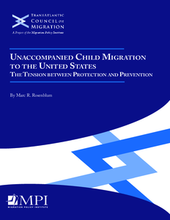This report examines the policy challenge in the United States of balancing protection and immigration enforcement in the recent unaccompanied child migration “crisis” in the US. The report provides an overview of unaccompanied child migration from Central America and Mexico to the United States since 2011 and a look into enforcement and protection policies in practice, including “special rules for families and children.” The report also seeks to explain the recent surge in migration from Central America and highlights the limitations and “unintended consequences” of the US immigration policy, particularly as it affects children.
The author finds that, while short-term policy measures enacted in the US have successfully slowed the pace of child and family migration to the US, their limited focus on deterrence and enforcement does not promote longer-term solutions, which, the author says, should include viable alternatives to migration, timely and fair adjudication of protection claims, and successful integration of migrants in the United States—or their reintegration in Central America upon return. The report concludes with recommendations to address this crisis, including attacking the drivers of migration (poverty, violence, etc), investing in Central American security and economic development, developing legal channels for migration, and improving adjudication processes.

